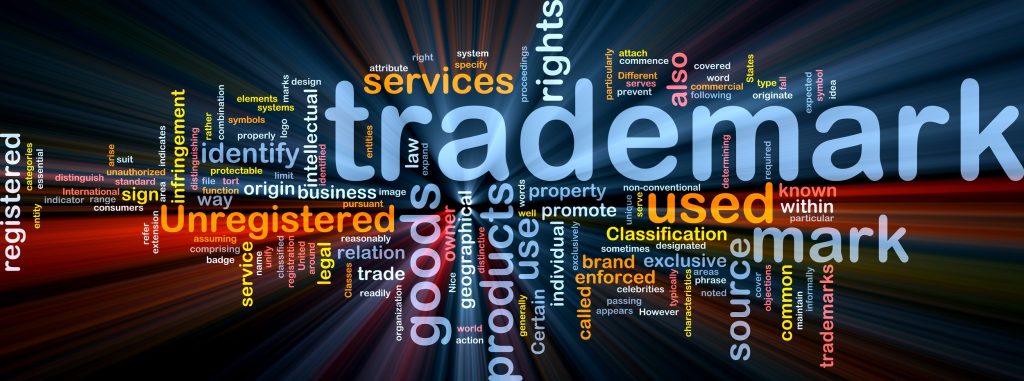With over 200 dedicated professionals, Beijing East IP has helped a full spectrum of clients – from startups to Fortune 500 corporations to domestic multinational companies – on their intellectual property issues in China.
-
Weekly China Trademark News Updates – September 27, 2022
2022-09-27
Weekly China Trademark News Updates
September 27, 2022
1. Using “HUAWEI” as a search keyword for products is considered as trademark infringement
Recently, the Shenzhen Futian District Court rendered a first-instance judgment on a trademark infringement dispute between Huawei Technologies Co., Ltd. (“Huawei”) and Shenzhen Mingyu United Technology Co., Ltd. (Mingyu United), and ordered Mingyu United to compensate Huawei for economic losses of RMB500,000 (USD69,000) and reasonable expenses of RMB1,069.8 (USD140).
Huawei obtained the exclusive right to use the registered trademarks “Huawei in Chinese” and “
 ,” and was approved to use them on Class 9 for headphones and other goods. The said trademarks are still valid.
,” and was approved to use them on Class 9 for headphones and other goods. The said trademarks are still valid.In this case, the accused infringing product is the same kind of product as those under Huawei’s registered trademark. The defendant set “Huawei in Chinese” as a search keyword and used the word “Huawei in Chinese” in its product name. “Huawei in Chinese” constitutes the same trademark as the Huawei’s registered trademark. Mingyu United used a graphic logo as the displayed picture. The graphic logo and Huawei’s registered trademark are both composed of the upper part of petals design and the lower part of English letters. The design parts on both marks are all in the shape of petals, and the overall visual effect is the same; the English letters “IEWAUH” are the same as Huawei’s. The English letters of the registered trademark “HUAWEI” have the same letter composition in reverse order. From an overall point of view, Mingyu United’s graphic logo is similar to Huawei’s registered trademark.
The search keyword “Huawei in Chinese” set by Mingyu United, the word “Huawei in Chinese” and the design logo used on the sales page of the accused infringing product have the function of identifying the source of the product and are trademark uses. Although Mingyu United indicated that the brand was SCOLIB in product details, and that the accused infringing product did not have the word “Huawei in Chinese” or a design logo, it set “Huawei in Chinese” as a search keyword and used “applicable to Huawei” and “original and genuine Huawei headphones,” in the product details, used design logos on the displayed photos, and labeled “Huawei in CHinese” in the product name and model details. These acts obviously showed the bad faith intention of takingadvantage of Huawei’s reputation, and it is very likely for the relevant public to believe that Mingyu United’s headphone is related to Huawei’s or that they have specific connections, which would cause confusion to the relevant public.
In summary, Mingyu United’s behavior of setting “Huawei” as a search keyword, using the word “Huawei in Chiness” in the product name, and using the design logo on the displayed photo infringed Huawei’s exclusive right to use its registered trademark, and should immediately stop the infringement and compensate for losses according to civil liabilities.
2. A company infringed Universal’s trademark by using the “Universal Studios in Chinese” mark without authorization
Universal City Studios LLC (also known as Universal Pictures Co., Ltd.) submitted a request to stop trademark infringement to the Beijing Tongzhou District Market Supervision Bureau (Tongzhou Supervision Bureau), requesting that the party’s use of the words “Universal Studios in Chinese” in the name of the hotel without the authorization of Universal constitutes trademark infringement.
On April 14, 2021, the Tongzhou Supervision Bureau came to a hotel franchise store based on clues provided by the trademark owner. After investigation, the party involved use the words “a hotel in Beijing Tongzhou Universal Studios” on electronic display screens, business cards, check-in receipts, temperature-measuring robots, health treasure QR code cards, hotel operation systems, and WeChat public account mini-programs in the hotel lobby without the authorization of the “Universal Studios in Chinese” trademark owner. The same words were also used on online platforms such as Ctrip, Dianping, Fliggy, Qunar, and eLong. As of the on-site inspection on April 14, 2021, the total operating revenue is RMB5.15 million (USD719,600).
The Tongzhou Supervision Bureau found that the above-mentioned behavior constituted trademark infringement, and ordered the party to stop the infringement immediately. In view of the party’s active cooperation and truthful account of the illegal facts and the initiative to provide evidence materials, immediate rectification was made at the scene, and at the same time considering that Universal Studios has not yet opened, the party’s infringement has limited impact on Universal Studios, the party was given a lighter punishment and imposed of an administrative penalty of RMB100,000 (USD13,900).
3. The CNIPA issued the “Notice on Comprehensively Implementing Online Applications for Rejection Appeal Cases” and “Interim Work Measures to Further Increase Trademark Opposition, Review, and Three-Year Non-use Cancellation Online Applications Filings”
Starting from November 1, 2022, trademark agencies should, in principle, submit electronic applications through the online trademark service system, and no longer submit paper materials.
In order to quickly and significantly increase online trademark opposition, review, three-year non-use cancellation filings. The CNIPA formulated and published Q&As guidelines for opposition, invalidation review, and three-year non-use cancellation, which aims to effectively guide applicants and trademark agencies to better use the online application system, deepen understandings, and improve efficiency.
In the next step, the CNIPA will further speed up the process of fully move trademark applications and responses electronically.


Follow us on LinkedIn!
Email: trademark@beijingeastip.com
Tel: +86 10 8518 9318 | Fax: +86 10 8518 9338
Address: Suite 1601, Tower E2, Oriental Plaza, 1 East Chang An Ave., Dongcheng Dist., Beijing, 100738, P.R. China -
Weekly China Trademark News Updates – September 20, 2022
2022-09-20
Weekly China Trademark News Updates
September 20, 2022
1. Unauthorized use of the exact same design as a Royal Oak watch constitutes trademark infringement and unfair competition, and RMB 1 million in damages
Recently, the Shenzhen Intermediate Court has rendered a judgment for Audemars Piguet Holding S.A. (“Audemars Piguet”) against Hengbo Zhang in a trademark infringement and unfair competition dispute. The court found that the defendants’ acts constituted trademark infringement and unfair competition, and ordered the defendants to compensate the plaintiff for economic losses and reasonable expenses of RMB 1 million (USD142,720).
Cited Marks 

Audemars Piguet manufactures, promotes, and sells self-branded watches. It launched the “Royal Oak” watch model in 1972. Audemars Piguet registered the “Royal Oak” trademarks (“Cited Marks”) on February 17, 1992 and September 12, 2016, respectively. The said trademarks were approved for use on goods in Class 14 for watches and jewelry. Audemars Piguet claimed that the defendant used a stylized “Royal One” logo (“Disputed Mark”) on a watch. When comparing the two, it can be clearly noticed that the similarity of the designs between the two. At the same time, the defendant’s watch copied the unique design features of the plaintiff’s “Royal Oak” and “Royal Oak Offshore” series of watches, including but not limited to the watches sold by the defendant under the name of “DIDUN DESIGN” that highly replicated the “Royal Oak” “Royal Oak Off Shore” series watch owned by Audemars Piguet.
The court found that the accused infringing goods were watches which were identical to the approved goods under the plaintiff’s Cited Marks. Compared with the Cited Marks, the logo “Royal One” on the accused infringing goods has a similar overall visual effect. In addition, compared with the plaintiff’s “Royal Oak” trademark, the artistic expression, visual effect and conceptual design of the “Royal One” logo on the alleged infringing goods were identical. In summary, the alleged infringing logo was similar to the Cited Marks, which may easily lead consumers into mistakenly believing that the goods sold under the infringer’s trademark originated from the plaintiff or that there was some connection between them, which constituted trademark infringement. Regarding unfair competition, Royal Oak and Royal Oak Offshore watches are well-known in the watch industry. The dial design of Royal Oak watches is very unique, which is different from ordinary watches. The shape has the function of distinguishing the source of the goods. The defendant used the exact same design as the Royal Oak watch without authorization, with the purpose of taking advantage of the goodwill of the Royal Oak watch, causing confusion or misleading of the relevant public. The defendant violated the principle of good faith and constituted an act of unfair competition as stipulated in Article 6(1) of the Anti-Unfair Competition Law.
2. A new round of amendments to the Trademark Law and its implementing regulations intend to clarify the civil liability for damages caused by bad faith squatting
A new round of preparations for the revision of the Trademark Law and its implementing regulations will pay more attention to the protection of rights and public interests, social effects, and balance of rights first, clarify the boundaries of the exercise of rights, solve the problem of insufficient maintenance of public interests, and promote a reasonable balance of rights and obligations. First, by strengthening the construction of integrity in the trademark fields, emphasizing that no deception or other improper means should be used to apply for or obtain trademark registration; study and clarify the liability for providing false materials; strengthen credit supervision and credit punishment. Second, to further regulate bad faith trademark registrations, and to study effective regulations by increasing the amount of fines, clarifying the civil compensation liability for losses caused to others by bad faith squatting, establishing a system for assigning bad faith squatted trademarks, improving prohibition rules for trademarks containing geographical names, and other measures to curb bad faith trademark registrations. Third, to regulate the exercise of rights, prevent abuse of rights, and clarify the boundaries of the exercise of the exclusive right to use a trademark. It is proposed to stipulate that registered trademarks may be revoked for the improper exercise of the exclusive right to use a trademark. The introduction of a bad faith litigation counter-compensation system is under research. Fourth, to strengthen the social nature of trademark examination and trial work, and plan to set up a discretionary procedure for revocation of preliminary publication. Fifth, to strengthen the supervision and management of the trademark agency industry, clarify the access requirements for the trademark agency industry, and standardize the trademark agency behavior.
Continue to strengthen the obligation to use trademarks, make up for its shortcomings on the basis of adhering to the existing registration system, and focus on solving the problem of “emphasizing registration and neglecting use.” First, improving the concept of trademark use and highlight the basic status of use. Second, on the basis of retaining the non-use cancellation system, study the feasibility of introducing a trademark use commitment and active submission of use during its registration. Third, adding regulations on revocation of trademarks ex officio. If the trademark registrant fails to fulfill the promise of use, fails to submit a description of the use according to law, or improperly exercises the exclusive right to use the trademark, the registered trademark can be revoked ex officio.
3. Alibaba Technology (Beijing) Co., Ltd. was fined for representing Eileen Gu’s trademark
On September 6, 2022, the Beijing Market Supervision Bureau issued an administrative penalty decision of Jingshi Jian Punishment [2022] No. 181 against Alibaba Technology (Beijing) Co., Ltd. to represent the trademarks “Gu Ailing in Chinese” and “EILEEN GU.” The penalty decision held that Alibaba represented the two applicants for a total of 4 trademarks in the “Gu Ailing in Chinese” and “EILEEN GU” trademarks in June 2019 and February 2020, which violated the provisions of Paragraph 3 Article 19, and Article 32 of the Trademark Law. A warning and a fine of RMB 80,000 (USD11,400) was issued.
The provisions of Paragraph 3, Article 19 and Article 32 of the Trademark Law stipulates that it is illegal when agency knowingly or should have known that its client filed trademarks that infringes others’ prior rights, but still accepts the entrustment. The Beijing Market Supervision Bureau believes that as a public figure and Olympic champion, Eileen Gu’s name itself has a certain influence and attraction and has an “endorsement” effect. If her name is registered as a trademark without authorization, this will not only infringe Eileen Gu’s name right, but will also infringe on the prior rights and interests of others, and easily affect their good public image. Therefore, anyone’s registration of “Gu Ailing in Chinese” and “EILEENGU” should abide by relevant laws and regulations. As a trademark registration agency, the party concerned knew or should have known about the content, but still accepted to act as the applicants’ entrusted agency to register and apply for the “Gu Ailing in Chinese” and “EILEEN GU” trademarks, which damaged Eileen Gu’s prior rights and caused adverse social impact.


Follow us on LinkedIn!
Email: trademark@beijingeastip.com
Tel: +86 10 8518 9318 | Fax: +86 10 8518 9338
Address: Suite 1601, Tower E2, Oriental Plaza, 1 East Chang An Ave., Dongcheng Dist., Beijing, 100738, P.R. China -
Weekly China Trademark News Updates – September 14, 2022
2022-09-14
Weekly China Trademark News Updates
September 14, 2022
1. The “Compliance Evaluation Guidelines for Digital Collections” – Digital collections can only be circulated for the purpose of use
On September 4th, at the 2022 World Frontier Technology Conference – Metaverse in the Digital Economy Forum of the Service Trade Fair, the ” Compliance Evaluation Guidelines for Digital Collections ” (Group Standards) (“Guidelines”) were officially released. The “Guidelines” regulates the definition, compliant issuance, and circulation of digital collections for the first time, and clearly states that digital collections are limited to the purpose of use, and cannot be listed or privately illegally traded for speculation, money laundering, tokenization, financialization, securitization, or other circulations.
The “Guidelines” pointed out that digital collections issued in China generally refer to a limited-release virtual cultural goods, including digital pictures, music, videos, 3D models, etc., which are recorded through blockchain technology of their distribution, purchase, and use histories. Such record on blockchain make it unique, non-copyable, tamperproof, and permanent proof. These goods are also known as “digital artworks” and “virtual digital goods.” As digital publications, digital collections can be distributed and circulated compliantly according to two product types: digital copyright and digital publication.
The relevant provisions stipulate that China implements a licensing system for publishing activities of electronic publications; without permission, no entity or individual may engage in publishing activities of electronic publications. This also means that no entity or individual may publish digital collections without permission.
2. 5 million RMB in damages! The Beijing IP Court found that the “red-soled shoes” constituted a goods name, packaging, and decoration with certain influence
Recently, the Beijing Intellectual Property Court rendered a decision for the plaintiff Christian Louboutin Co., Ltd. (“Louboutin”), Lanbuting Shanghai Trading Co., Ltd. (“Lanbuting”) and against the defendant Guangdong Wanlima Industrial Co., Ltd. (“Wanlima”) in a first-instance judgment of an unfair competition dispute involving “red-soled shoes.” Wanlima was ordered to stop infringement, compensate economic losses of RMB 5 million (USD718,000) and reasonable expenses of RMB 445,000 (USD63,900), and ruled that the retailer would not be liable for indemnify the damages but is responsible for RMB 5,000 (USD718) in reasonable expenses.
The Beijing IP Court found that: First, the name of the goods that the plaintiffs Louboutin and Lanbuting requested for protection in accordance with Article 6(1) of the Anti-Unfair Competition Law was the name “red-soled shoes.” A decoration that has a certain influence is the red decoration used on the outer sole of women’s high-heeled shoes. The key to judging whether the parties have a direct interest in this case is to determine whether the interests contained in the trade name of the “red-soled shoes” involved in the case and the decoration of the red soles have the basis for substantive law protection for the parties. The evidence submitted by the two plaintiffs in this case can prove that the decoration and product name involved have established a stable correspondence with Louboutin among consumers, and it can be determined that the rights and interests of the decoration and product name involved belong to Louboutin. However, the evidence in the case can only prove that Lanbuting is an authorized agent of Louboutin, and cannot prove that the decoration and product names involved have established a stable corresponding relationship with Louboutin, and thus it cannot be proved that Lanbuting has a direct interest in this case.
Second, Louboutin submitted relevant evidence to show that it has actually sold footwear products in mainland China since 2011, with sales more than RMB900 million (USD129 million). Louboutin has been promoting “red-soled shoes” products since 2003 in mainland China. Many well-known media have reported Louboutin’s products nation-wide. Based on the above evidence, it was sufficient to prove that its “red-soled shoes” product and red sole decoration have a high market reputation and have established stable relationship with the relevant public and have the distinctive feature of distinguishing the source of the goods. Therefore, Louboutin’s “red-soled shoes” product name and the red sole decoration are product name and decoration with “certain influence” as referred to in Article 6(1) of the Anti-Unfair Competition Law. Wanlima used the same or similar logos with the brand name and red sole decoration of the “red-sole shoes,” which had certain influence with Louboutin, without authorization. Such use was enough to cause misunderstanding that Wanlima had some specific connection with Louboutin, and its behavior violated the provisions of Article 6(1) of the Anti-Unfair Competition Law and constituted unfair competition.
Since the determination of whether Lanbuting has an interest in this case is inseparable from the determination of the rights and interests of the “red-soled shoes” trade name and red sole decoration involved, and considering the principles of litigation economy and efficiency, the Beijing IP Court dismissed Lanbuting’s lawsuit, ordered Wanlima to stop the infringement, and compensated Louboutin for economic losses of RMB 5 million (USD718,000) and reasonable expenses of RMB 445,000 (USD63,900), and held that the retailer to be responsible for reasonable expenses of RMB 5,000 (USD718).
3. Cisco successfully invalidated the “CSCO” mark
The appellant Beijing Heathco Clinical Oncology Research Foundation (“Heathco Foundation”) and the appellee, the CNIPA, and the third party in the original trial, Cisco Technology Corporation (“Cisco”) were involved in an administrative dispute over a trademark invalidation request. The Beijing High Court recently rejected the appeal and affirmed the first instance decision.
Disputed Mark Cited Mark 1 Cited Mark 2 Cited Mark 3 Cited Mark 4 Cited Mark 5 





Regarding the first issue in this case, whether the CNIPA deprived the co-owners of the Disputed Mark the opportunity to make a statement and reply during the administrative review of the invalidation, which damaged the procedural rights and interests of the co-owners of the Disputed Mark and constituted a procedural violation. The Beijing High Court found that the Heathco Foundation did not raise any objection to the procedure made by the accused ruling in the original litigation, so this court tried it on the basis of the principle of comprehensive review. The Disputed Mark was jointly owned by the Heathco Foundation, the China Society of Clinical Oncology Co., Ltd., and the Clinical Oncology Collaborative Professional Committee of the China Anti-Cancer Association. According to the “Reply to the Invalidation of the “CSCO and Design” mark with reg. no. No. 12359367 submitted by the Heathco Foundation to the CNIPA at the administrative stage, it can be seen that the co-owners of the Disputed Mark designated the Heathco Foundation as the representative, so it was legal for the CNIPA to deliver the relevant documents regarding the notification of invalidation of the Disputed Mark to the Heathco Foundation, which did not deprive the co-owners of the Disputed Mark the opportunity to make a statement and reply, and was not a procedural violation.
Regarding the second issue in this case, whether the Disputed Mark and the Cited Marks constitute similar trademarks of identical or similar services. The court found that “education” and other services approved and used by the Disputed Mark and the “educational information” and other services approved and used by the Cited Marks 1 to 5 fall into the same class according to the “Classification of Similar Goods and Services issued by the CNIPA.” There were many overlaps in terms of content, methods, and target consumers. The Disputed Mark consisted of the letters “CSCO” and a design, and its distinctive identification part was the letters “CSCO.” The Cited Mark 1 to 3 consist of the letters “CISCO.” The Cited Mark 4 consists of the letters “CISCO” and a design, and its distinctive identification part is the letters “CISCO.” The Cited Mark 5 consists of the letters “CISCOSYSTEMS” and a design, and its distinctive identification part is the letters “CISCOSYSTEMS.” There was only one word difference between the distinctive parts of the Disputed Mark and the Cited Marks 1 to 3 and the Cited Marks 4 and 5. The Disputed Mark and the Cited Marks 1 to 5 were similar in terms of text composition, pronunciation, and overall visual effect. When the Disputed Mark and the Cited Marks 1 to 5 were used in the same service in “education” or other similar services, it would be easy for the relevant public to believe that the service originates from the same subject or that there is a specific connection between the origin entities, which would result in confusion and misidentification. Although the Heathco Foundation has submitted some evidence of its use of the Disputed Mark, it was not enough to prove that the Disputed Mark can be distinguished from the Cited Marks 1 to 5 through use. Therefore, the Disputed Mark and the Cited Marks 1 to 5 constituted similar trademarks used on identical or similar services under Article 30 of the 2013 Trademark Law. The original judgment was correct and affirmed.


Follow us on LinkedIn!
Email: trademark@beijingeastip.com
Tel: +86 10 8518 9318 | Fax: +86 10 8518 9338
Address: Suite 1601, Tower E2, Oriental Plaza, 1 East Chang An Ave., Dongcheng Dist., Beijing, 100738, P.R. China -
Weekly China Trademark News Updates – September 7, 2022

Weekly China Trademark News Updates
September 7, 2022
1. Trademark rejection appeal cases will move fully online
On September 5, 2022, the CNIPA issued a notice that in order to further improve the digitization and greenify of trademark reviews, the CNIPA will fully move all rejection appeal cases online. Starting from November 1, 2022, trademark agencies should, in principle, submit electronic applications through the online trademark service system for rejection appeal and should not submit anything in paper.
2. MISS TOUR WORLD vs. MISS WORLD
Miss World LTD (“Miss World”) manages the international competition of Miss World Tourism based on its trademarks such as “Miss World in Chinese” (Reg. Nos. 3796247, 12346489), “MISS WORLD” (IRN. 816100, Reg. No. 12346493)” and filed an invalidation against the “Miss World Travel in Chinese and Figure” mark (“Disputed Mark”).
Disputed Mark Cited Marks 


The Beijing Intellectual Property Court and the Beijing Higher People’s Court found that the services other than animal taming approved for the Disputed Mark were the same as the approved services of Cited Marks 1 to 4 in organizing education or entertainment competitions, book publishing, and providing models for artists, or other similar services. The evidence provided by Miss World for the “Miss World in Chinese” and “MISS WORLD” marks proved that it has organized and held the first Miss World beauty contest since 1951 and has been held in many countries prior to the Disputed Mark’s application date. A total of 64 events have been held, and many events have been held in China, and some Chinese attendees have won the championship. Since 2001, a number of Chinese media have promoted and reported on the Miss World contest and used the “Miss World in Chinese” and “MISS WORLD” marks, which has resulted in a corresponding relationship between “Miss World in Chinese” and “MISS WORLD.” “Miss World in Chinese” and “MISS WORLD” were also known to the relevant public in China. The Disputed Mark consists of “Miss Tour World in Chinese and MISS TOUR WORLD” and design, of which the text “Miss Tour World in Chinese and MISS TOUR WORLD” was its main identification part. The Cited Marks “Miss World in Chinese” and “MISS WORLD” were completely included in the Disputed Mark and they were also similar in pronunciation, words composition and other aspects, which constituted similar marks. If the Disputed Mark coexists with the Cited Marks on the approved services other than the “animal taming” service, it would be easy for the relevant public to confuse and misidentify the source of the service. Most of the evidence submitted by Miss Tour World Company were formed from 2009 and later, which was not sufficient to prove that the Disputed Mark has enjoyed certain fame before the date of application of the Cited Marks, so that it can be distinguished from Cited Marks. At the same time, the evidence submitted by Miss World can prove that before the Disputed Mark’s application date, the trade names “MISS WORLD” and “Miss World in Chinese” used on the “Organizing Beauty Pageant” service have already enjoyed certain fame, and the main identification part of the Disputed Mark completely includes Miss World’s prior used trade name. The services approved and used by the Disputed Mark were closely related to the “organizing beauty pageant” service provided by Miss World in terms of service content and objects, and should be identified as the same or similar services. Therefore, the registration of the Disputed Mark constituted the situation under Article 32 of the 2013 Trademark Law where “a trademark application shall not damage the existing prior rights of others.”
3. A “Playlist in Chinese” trademark was ruled as a deceitful trademark
The “Playlist in Chinese” mark with reg. no. 11934833 (“Disputed Mark”) owned by Hangzhou NetEase Cloud Music Technology Co., Ltd. (“NetEase”) was approved for registration on August 14, 2015, and was approved for use in “electronic publications (downloadable); computer programs (downloadable software); computer software (already downloaded)” recording); computer game software; mobile phones; network communication equipment; cartoons; recorded computer programs (programs); cameras (photography)” and other goods. Huijia Asia Co., Ltd. (“Huijia”) filed an invalidation against the Disputed Mark. The Beijing High Court found that the Disputed Mark can be understood as a collection of songs summarizing the names of song works, performers and other information according to different needs and preferences. Data processing activities such as information data collection, selection, sorting, etc., whose application involve entertainment, education, and other activities. Using such a mark on the said data processing activities or entertainment, education-related products would be easy to confuse relevant consumers that such a mark was describing the said data processing activities, which made it difficult to identify such a mark to distinguish the source of the goods. The courts held that the Disputed Mark lacked the distinctive characteristics that a trademark should have, which constitutes the situation in the second item of Article 11, Paragraph 1 of the 2013 Trademark Law. When the above-mentioned products were not related to music or song-related information data processing activities, music or song-related entertainment and educational activities, the “Playlist in Chinese” mark was likely to cause the relevant public to misunderstand the characteristics of the said goods and constituted the circumstances in the provisions of Article 10, Paragraph 1, Item 7 of the 2013 Trademark Law. The understanding of the meaning of a symbol should be based on the general cognitive habits and abilities of the relevant public. NetEase’s claim that the “Playlist in Chinese” mark had a special meaning is unfounded, and the evidence provided by NetEase was insufficient to prove that the Disputed Mark has been used to obtain recognition as a trademark. The distinctive features of the Disputed Mark were not enough to prove that it has established a unique correspondence with it, and the court did not support the relevant claims of NetEase. Accordingly, the Beijing High Court reversed the first-instance judgment made by the Beijing Intellectual Property Court and held that the trademark should be invalidated.


Follow us on LinkedIn!
Email: trademark@beijingeastip.com
Tel: +86 10 8518 9318 | Fax: +86 10 8518 9338
Address: Suite 1601, Tower E2, Oriental Plaza, 1 East Chang An Ave., Dongcheng Dist., Beijing, 100738, P.R. China -
Weekly China Trademark News Updates – September 2, 2022
2022-09-02
Weekly China Trademark News Updates
September 2, 2022
1. China’s trademark filings show negative growth for the first time in 15 years
From January to June 2022, the CNIPA received a total of 3.9 million trademark applications, a year-on-year decrease of 18.75%. Among them, there were 2.6 million on goods, a year-on-year decrease of 18.95%, and 1.3 million on services, a year-on-year decrease of 18.36%.
The data shows that the most popular classes are Class 35 for advertising sales, Class 30 for food, Class 9 for electronic equipment,a Class 29 for meat, Class 43 for catering, Class 25 for clothing, shoes, and hats, and Class 33 for wine, Class 5 for pharmaceuticals, Class 41 for education and entertainment and Class 42 for technology services., a year-on-year decrease of 9.88% to 33.45%.
2. The Beijing IP Court issued a report on “Transitional Guiding Period” for Online Case Filing
With the normalization of epidemic prevention and control, in order to fully implement key tasks such as optimizing business environment, help the right owners to enforce their rights, and build a more complete litigation and trial platform, the Beijing Intellectual Property Court issued, on July 25, 2022, the “Announcement on Comprehensive Implementation of Online Filing of Administrative Cases for Patent and Trademark Right Granting and Verification.” From September 1, 2022, online filing will be fully implemented in administrative cases of patent and trademark right granting and verification in which an agent is entrusted to participate in the litigation. In the nearly one month since the release of the Announcement, there were 4,974 first-instance cases directly filed online to the Beijing IP Court, accounted for 66% of the total first-instance cases.
3. The Beijing High Court reversed the CNIPA’s ruling and the first-instance judgment, finding that the coexistence of “Zimeitang” and “Shiseido in Chinese” will not cause confusion and misidentification
Shiseido Co., Ltd. (“Shiseido”) cited the “Shiseido in Chinese” trademarks on October 14, 2019 to invalidate the “ZIMEITANG in Chinese ” mark with reg. no. 28197986 registered and used by Beijing Zimeitang Co., Ltd. (“Zimeitang”) on cosmetic goods in Class 3. The CNIPA found that the two parties’ marks were similar and in favor of Shiseido.
Disputed Mark Cited Mark 1 Cited Mark 2 


Zimeitang appealed the unfavorable decision with the Beijing IP Court. Both parties submitted a large amount of evidence to prove the fame and use of their respective trademarks during the CNIPA review and the court trial proceedings. The Beijing IP Court found that the evidence provided by Shiseido proved that the Cited Marks had a high reputation among Chinese consumers in cosmetics and other goods before the Disputed Mark’s application date, especially that the Cited Marks were recognized as famous marks on “cosmetic” goods to the public by the original Trademark Office in as early as April 2009. The Disputed Mark was similar to the Cited Marks in terms of font, pronunciation, etc. Although Zimeitang has provided a large amount of use evidence to prove that the Disputed Mark has been used for many years and has formed a corresponding relationship with it, given that the Cited Marks were registered earlier and has a high reputation, it would be difficult for the relevant public to distinguish the two when paying general attention, so the CNIPA decision should be affirmed.
Zimeitang appealed the first-instance judgment to the Beijing High Court. In the second-instance procedure, it further submitted evidence to prove the use and popularity of its trademark.
The Beijing High Court found that the Disputed Mark was composed of the Chinese characters “ZI MEI TANG,” while the Cited Mark 1 and 2 are composed of the Chinese characters “Shiseido in traditional Chinese” and ” Shiseido in simplified Chinese” respectively. Although all trademarks contain the character “Tang in Chinese,” based on common market habits, the character “Tang”, which could mean hall, is often used as a suffix for trademarks or trade names. It does not play a role in distinguishing and identifying, so it does not constitute a distinctive identification part of the above-mentioned trademarks. The distinctive characters “Zimei in Chinese” of the Disputed Mark were completely different from the characters “Zisheng in traditional Chinese and “Zisheng in simplified Chinese” in the Cited Marks 1 and 2, and their meanings were also significantly different. The difference was obvious in the overall comparison, and the relevant consumers can distinguish them. Although Shiseido’s Cited Marks have a high reputation, the evidence provided by Zimeitang can also prove that the Disputed Mark has been used on a certain scale and has obtained a certain popularity and influence. The coexistence of the Disputed Mark and the Cited Marks on the approved goods would not cause confusion and misunderstanding, so the registration of the Disputed Mark did not violate Article 30 of the Trademark Law2013. The CNIPA decision and original judgment were incorrect and the Beijing High Court shall correct them. Since the new evidence provided by Zimeitang in the lawsuit was not the basis for the ruling of CNIPA decision, the CNIPA was not at fault and Zimeitang was still responsible for the court fees.
4. Frescobaldi finally removed a similar mark after the court determined that tea drinks, sweets (candy), etc. were similar to wine
Marchesi Frescobaldi Societa Agricola S.R.L. (“Frescobaldi”) filed successively an opposition, an invalidation, first instance and second instance administrative lawsuits to remove the “Frescobaldi” trademark in Class 30 for “tea-based beverages; confectionery [candy]; chocolate; pastries; bread; biscuits; rice-based snack food” from the registry.
Disputed Mark Cited Marks 1 and 2 Cited Marks 3 – 6 


Class 30: Tea-based beverages; Confectionery [candy]; Chocolate; Pastries; Bread; Biscuits; Rice-based snack food Class 29: Oil, extra virgin olive oil. Class 33: Wines, sparkling wines, liqueurs
Class 29: Edible fats; Fruit, preserved; Vegetables, preserved, etc. Class 33: Wine; Alcoholic beverages, except beer; etc.
Class 43: Bar and restaurant services
Both CNIPA’s invalidation decision and the Beijing IP Court’s first instance decision found that the Disputed Mark did not violate Article 30 or Article 44(1) of the Chinese Trademark Law. Frescobaldi appealed to the Beijing High Court.
The Beijing High Court found that according to the facts proved by the evidence on record, Frescobaldi’s FRESCOBALDI winery has a long history, and the “FRESCOBALDI” wine produced by it has been sold and promoted in mainland China through Chinese distributors since 2006. In terms of wine products, for the relevant Chinese public, “Hua Si Die in Chinese” and “FRESCOBALDI” have formed a commercial correspondence through long-term use. The registrant of the Disputed Mark, as a relevant public in China, deliberately applied for the registration of the “Frescobaldi” trademark, which was identical to the Cited Marks 1 and 2 and has a corresponding relationship with the Cited Marks 3 to 6. Although the Disputed Mark was used sparingly, it was not enough to eliminate the subjective bad faith of its application for registration.
In this case, Frescobaldi did not submit evidence of the use of the Cited Marks for goods in Class 29. Considered that tea drinks, sweets (candy) and other goods approved and used by the Disputed Mark were significantly different from goods in Class 29, so these marks’ coexistence in the market was not enough to create a likelihood of confusion. However, the evidence in the case can prove that Frescobaldi’s “FRESCOBALDI” wine has gained a certain reputation in the Chinese market after being promoted and used. Tea beverages, sweets (candy) and other goods designated by the Disputed Mark and the Cited Marks’ approved goods for wine and other goods in Class 33 were commonly used in foods in daily life, and the two were similar in function, use, sales channels, consumer groups, etc. According to the circumstances of this case, these goods could be categorized as similar goods. The Cited Marks “Hua Si Die in Chinese” and “FRESCOBALDI” were highly distinctive, and the Disputed Mark was identical or corresponded with Cited Marks and should be judged as similar marks. If the Disputed Mark and the Cited Marks were used on the above-mentioned goods, it would be easy for the relevant public to confuse and misunderstand the source of the goods. Therefore, the Disputed Mark constituted as a similar mark used on identical or similar goods, and the CNIPA decision and the first instance court judgment were incorrect and this court has corrected them.


Follow us on LinkedIn!
Email: trademark@beijingeastip.com
Tel: +86 10 8518 9318 | Fax: +86 10 8518 9338
Address: Suite 1601, Tower E2, Oriental Plaza, 1 East Chang An Ave., Dongcheng Dist., Beijing, 100738, P.R. China -
Repeated trademark infringer fined for RMB 4.9 million
Repeated trademark infringer fined for RMB 4.9 million
Background
Vans, Inc. (“Vans”) sued Wenzhou Shuangxiang Co., Ltd., (“Shuangxiang”) for infringing its trademark right when Shuangxiang manufactured and sold shoes using Vans’ Cited Marks and requested the court to order quintuple punitive damages based on Shuangxiang’s unjustified gains. Vans claimed that not only did Shuangxiang infringed its trademark right by manufacturing and selling shoes using its Cited Mark, but Shuangxiang also knowingly continued its infringing activities after multiple local Administration for Market Regulation (“AMR”) raids and penalties issues. Vans found that Shuangxiang sold its infringing products through an associated company Chengdu Maijia Co., Ltd. (“Maijia”) and requested to have both companies to be held jointly liable. The court held against Shuangxiang and Maijia for infringing Vans’ trademark right and ordered RMB 4.89 million (USD 767,500) in economic loss and RMB 10,072 (USD 1,580) in reasonable legal costs.
Cited Marks 
Reg. No.: 21171127A
Reg. Date: Nov. 7, 2017Infant full suits; swimwear; costumes for masquerade balls; shoes (things worn on the feet); dress belts (clothes); wedding dresses; eye masks for sleep; shower caps; dress ribbons; 
Reg. No.: 4724337
Reg. Date: Aug. 28, 2014Children’s clothing; trousers; underwear; bathrobes; outerwear; T-shirts; pajamas; garments; underpants; infant full suits; costumes for masquerade parties; soccer shoes; running shoes with metal spikes; shoes; metal accessories for shoes and boots; soles; Shoe heels; Insoles; Boots and Shoe Skids; Boots; Garment Ribbons; Shower Caps; Wedding Dresses. 
Reg. No.: 8606383
Reg. Date: Sep. 14, 2011Ski boots; snowboard boots; sports shoes; shoes; boots. Issues
- Trademark infringements
- Trademark use
The defendants argued that the following marks were used only as decorations on the side of the shoes but not as trademarks. For shoes related products, however, labeling logos on both sides of a shoe can effectively convey the source of the products to consumers. Even if these logos were decorative use, such decorative use will not diminish its distinctive functionality. Therefore, the disputed logos constitutes as trademark use.
Disputed Logos 



- Similarity between the Cited Marks and the Disputed Logos
The Disputed Logos were consistent with the Cited Marks, and the subtle differences in graphics and texts were unlikely to catch consumer’s attention. Considering Vans has been publicizing and promoting its Cited Marks on its highly popular and distinctive skateboard shoes, when general consumers paying general attention to the Disputed Logos, they were likely to be confused regarding the source of the goods or mistaken that the source of goods was associated with Vans. Therefore, the Disputed Logos constituted as similar marks to the Cited Marks.
- Joint liability
Although the alleged infringing acts were carried out by Shuangxiang and Maijia, both companies were actually owned by a mother-son duo Xiang Jin and Xiulu Li. Together, they manage all manufacture, sales, contacts, payments, delivery, and everything else related to running a business. In particular, Xiang Jin, the mother, carried out every infringing activity and directly received unjustified benefits from the infringements. Therefore, all defendants were jointly liable.
- Punitive damages
- Applicability of punitive damages
Shuangxiang infringed Vans’ trademark right multiple times and received administrative punishments, however, Shuangxiang carried on its infringing acts. Additionally, Maijia, a company controlled by Shaungxiang’s owner Xiang Jing also infringed Vans’ trademark right. The relationship and acts between the two companies should be seen as intentionally infringing Van’s trademark right and punitive damages should be applied.
- Determining the defendants’ sales amount
Vans requested the court to retrieve sales amount of Shuangxiang and Maijia from 1688 and Tmall platforms. The parties agreed that those alleged infringing products marked with “successful transaction” on the platforms totaled RMB2.39 million (USD 375,325). The defendants, however, argued that the number may not be the most accurate number and should be reduced because there was a possibility of faked transactions.
The court reasoned that sales amount was an important factor for consumer’s selection of products on e-commerce platforms. Creating fake sales, however, would present an image to consumers that the defendants’ shops were popular and trusted, which would likely to lure and mislead consumer to purchase at the defendants’ shops. Creating fake sales violated the principal of good faith and the court would not support the defendants’ claim to reduce the sales amount collected from the platforms.
- Calculating actual damages
The defendants had operated its infringement business between 2017 and 2021 and failed to provide its own profit when the court requested. Thus, the court calculated the defendants’ profit based on 50% of the gross profit margin of Vans’ Chinese licensee. Such reference can be rectified by publicly available industry numbers and the sales numbers provided by the defendants. Not to mention that the defendants operated infringement business, which should have obtained higher profit margin than companies in the same industry.
- Determining actual damages
Considering the defendants’ continuous and large scale of infringements on Vans’ trademark right and Vans’ high fame, the defendants’ acted with bad faith and the infringement circumstances were serious, the court ordered treble damages based on the defendants’ acts and the evidence provided.
Takeaways
- Logos placed on two sides of the shoes are eye-catching and can effectively convey to consumers the source of goods. The decorative purpose of logos will not decrease its function to distinguish the source of goods.
- Continuous infringements by an infringer and its accomplice after receiving multiple administrative punishments should be considered as intentional infringement. When the circumstances are serious, punitive damages should be applied.
- When calculating damages, profits calculated based on defendant’s sales price and industrial average profit can be consider in order to determine the final base for damages calculation.
- Although generating fake purchase records can effectively reduce infringer’s actual profit, such records still negative impact rights owner’s marketing strategy, product’s goodwill, and market share.


Follow us on LinkedIn!
Email: trademark@beijingeastip.com
Tel: +86 10 8518 9318 | Fax: +86 10 8518 9338
Address: Suite 1601, Tower E2, Oriental Plaza, 1 East Chang An Ave., Dongcheng Dist., Beijing, 100738, P.R. China -
Weekly China Trademark News Updates – February 22, 2022
2022-02-22
Weekly China Trademark News Updates
February 22, 2022
CNIPA answers the frequently asked questions regarding the Trademark Adjudication and Examination Guideline
Part I – Adjudication and Examination of Trademark Distinctive Features
1. How is trademark distinctive features adjudicated?
The types of “other lack of distinctive features” stipulated in Article 11(i)(3) of the Chinese Trademark Law gradually increases. To meet new technologies and new business formats developments, the Trademark Adjudication and Examination Guidelines (“Guidelines”) comprehensively summarizes practical experiences of trademark examinations in recent years, which refines and supplements “other lack of distinctive features” that are more common in practice:
First, modify the distinctiveness determination of packaging, container, or decorative pattern of the goods designated by the trademark. The Guidelines further clarifies that the outer packaging of goods where “consumers will not generally regard it as a trademark that distinguishes the source of goods or services” does not have distinctive features of a trademark, and the container or decorative patterns of the goods themselves do not have distinctive features of a trademark.
Second, in practice, “commonly spoken words,” “Internet buzzwords and popular emoji packs,” and “aphorisms” are part of the public’s daily expressions and do not have distinctive features that a trademark should have.
Third, marks that “only contain the full name of an applicant (excluding natural persons),” “commonly used symbols,” and “festival names” are difficult to be identified as trademarks and lack distinctive features that trademarks should have. Common signs and symbols include a variety of those used in daily life or work. Festive names include not only the legal festival names, but also customary ones.
The Guidelines, however, cannot exhaustively enumerate all situations in which a sign “lacks distinctive features.” As for whether a certain sign lacks distinctive features, it is still necessary to make a case-by-case judgment in light of the actual situation.
2. How to determine distinctiveness if a mark is used as the full name of its corporate name?
Generally speaking, if there is only the full name of an applicant (excluding natural persons), it does not have distinctive features that a trademark should have, except for those with graphics and other elements that make the entire mark have distinctive features.
But it is worth noting that in recent years, more and more universities, research institutes, hospitals, social groups and other institutions or other organizations have registered their full names as trademarks. The brand value of its name increases the use of intangible assets. The full names of some institutions or organizations have been used for a long time and have a high reputation, and have created a one-to-one correspondence with the goods or services actually used by the relevant institutions or other organizations, which will not cause confusion and misunderstanding to consumers. Such marks can be used to distinguish the source of goods or services provided and shall be deemed to have distinctive features of a trademark.
3. Why amend the distinctiveness determination criteria for trademarks containing signs that do not have distinctive features?
The second part of the “Examination of Distinctive Features of Trademarks” in the outdated Trademark Adjudication and Examination Standards stipulates that a trademark is composed of signs and other elements that do not have distinctive characteristics. If other elements or the trademark as a whole can play the role of distinguishing the source of goods and services, that trademark has distinctive features.
However, in practice, if a trademark is composed of a design and a text, independently, where the design has certain distinctive features but the text lacks distinctive features, if directly determined such mark has distinctive features just because the design has distinctive features would create a series of problems. First, this determination method is contrary to the principle of overall determination of trademark distinctiveness and would easily create ambiguity as to the scope of trademark protection. Second, in practice, some trademark registrants use such trademarks on e-commerce platforms for the purpose of blackmailing or filing malicious infringement complaints. Third, this standard is also inconsistent with the current practice of trademark authorization and confirmation. In relevant trademark administrative or judicial cases, it is generally believed that a trademark is composed of design or text alone, and the text part is the dominant part of the trademark. If the text part lacks distinctive features, the entire trademark shall be deemed to lack distinctive features.
Therefore, after sorting out and summarizing relevant cases, soliciting opinions from courts and scholars at all levels, and rounds of discussions, the Guidelines updated the standard for determining trademark distinctiveness containing signs that do not possess distinctive features by clearly stating that “if a trademark is composed of an independent text part and other independent where the text part does not have distinctive features, the entire trademark shall be deemed to lack distinctive features.” At the same time, in order to fully protect the rights and interests of applicants and regulate the conduct of trademark adjudication and examination, the Guidelines points out, “If other elements have strong distinctive features, and the trademark registration department believes that it is possible to distinguish the source of goods or services based on these elements, it may issue an examination opinion requiring the applicant to give up the exclusive right to the part lacking distinctive features. If the applicant does not give up or fails to respond to the examination opinion within the prescribed time limit, its application for trademark registration shall be rejected.”
Part II – Adjudication and Examination of Well-Known Mark
1. What changes are made to the evidentiary requirements for the recognition of well-known trademarks?
The well-known mark determination part of the Guidelines has updated the scope of submission of some evidence, use evidence formed by non-traditional business methods and non-traditional media are now recognized. Additional forms of evidence submission are allowed according to the situation. For example: in addition to traditional evidence such as contracts, invoices, bills of lading, bank receipts, import and export certificates, etc., relevant materials such as online e-commerce sales records are added as evidence of trademark use. When examining relevant evidence of geographical areas of sales, point of sales, sales channels and methods, traditional business methods and non-traditional business methods are included. When reviewing media advertisements, comments, reports, rankings and other promotional materials, traditional media and non-traditional media, etc. are included. When reviewing tax payment for relevant evidence, in addition to the original tax payment certificate issued by the tax authority and the notarized copy of the tax payment certificate, a notarized electronic version of the tax payment certificate printed copy is now allowed.
2. What other amendments to the “Guidelines” concerning the recognition of well-known marks should applicants and agents pay attention to?
First, provisions on the re-protection of well-known marks that have been previously identified have been added, which added specific conditions for application. Evidence materials that the well-known trademark holder needs to submit when requesting to re-protect a well-known mark are also added. In particular, evidence during the time when the mark was protected as a well-known mark and other relevant evidence should be submitted.
Second, the definition of “translation” of other’s well-known mark is refined based on practice. If the disputed trademark expresses another’s well-known mark in different languages, and if those languages have established a corresponding relationship with that other’s well-known mark and are well known or used by the relevant public, such translated mark constituted as a “translation” as stipulated in Article 13(ii) of the Chinese Trademark Law. If such use of the words in another language is likely to make the relevant public mistakenly believe that it has a considerable degree of connection with the well-known trademark of others, such mark shall also be deemed as a “translation.”
Third, no longer make a clear distinction between “confusion” and “misleading,” and to combine the description of “specific situations,” so as to better meet the requirements of trademark examination and adjudication practice.


Follow us on LinkedIn!
Email: trademark@beijingeastip.com
Tel: +86 10 8518 9318 | Fax: +86 10 8518 9338
Address: Suite 1601, Tower E2, Oriental Plaza, 1 East Chang An Ave., Dongcheng Dist., Beijing, 100738, P.R. China -
Weekly China Trademark News Updates – February 15, 2022
2022-02-15
Weekly China Trademark News Updates
February 15, 2022
1. LEGO successfully enforced its minifigures 3D trademark
Recently, the Huadu District Court of Guangzhou, Guangdong rendered a trademark infringement decision in favor of LEGO against Guangzhou Zhongnuo Trading Co., Ltd. (“Zhongnuo”) and Shen Xiaoyu for using the “LEGO” logo and LEOG’s minifigures logo on school bags, stationery boxes, and wallets, which infringed LEGO’s prior trademark rights. LEGO’s “LEGO” and “LEGO in Chinese” marks were recognized as well-known trademarks by the Beijing High Court in 2017 on toy products. LEGO also owns the “LEGO” mark and the minifigures 3D trademark on school bags, backpacks, etc. in Class 18.
Reg. No. 4912052 Reg. No. 10461954 

The court found that the accused infringing goods were schoolbags, stationery boxes and wallets, which were the same or similar to the approved use scope of LEGO’s trademarks No. 4912052 and No. 10461954, and the accused infringing logos were used on the front of the goods, hang tags, zipper pullers, shoulder straps, sewing labels, etc., which carried the function of identifying the source of goods. After comparison between the infringing logos and LEGO’s registered trademarks, the accused infringing logos are identical or similar to LEGO’s trademark with reg. no. 4912052. Comparing the alleged infringing logo with LEGO’s trademark with reg. no. 10461954, the composition elements, design style, and visual effects were similar, which constitutes as similar. Although the defendant claimed that the pattern used on the accused infringing goods was the same as its own artwork “Robots and Small Yellow Minions,” the court found that the pattern to be similar to the LEGO’s trademark with reg. no. 10461954. What’s more, the trademark with reg. no. 10461954 has been registered since December 14, 2013. The completion date of the artwork “Robots and Small Yellow Minions,” however, was on October 10, 2015. The defendant used evidence created after LEGO’s prior right, which cannot be supported. The court ruled in favor of LEGO and ordered the defendant to pay LEGO’s economic losses and reasonable legal costs of RMB130,000 (USD20,471).
2. The CNIPA cracks down on trademark squatting related to popular keywords used during the 2022 Beijing Winter Olympics
On February 14, 2022, the CNIPA issued the “Notice on Combating the Malicious Squatting of “Bing dun dun,” “Gu Ailing,” and Other Trademarks.” Prior to the start of the 2022 Beijing Winter Olympics, the CNIPA have been cracking down on squatted trademark applications and registrations based on its mascot “Bing Dun Dun” and other famous athletes. So far, 427 of such squatted applications or registrations have been rejected or invalidated.
The CNIPA attaches great importance to the protection of intellectual property rights during the 2022 Beijing Winter Olympics and the 2022 Beijing Winter Paralympics by carrying out special campaigns against malicious trademark squatters. In addition to protecting the trademarks applied by the Beijing Winter Olympics Organizing Committee, and the names of popular athletes such as “Gu Ailing” and others, the CNIPA cracked down on other bad faith trademark squatters by rejecting bad faith applications of “Bingdundun” and “Gu Ailing” and some 429 other applications. The CNIPA also invalidated 43 other registered trademarks sua sponte, including “Xue dun dun” and “Gu Ailing.”
3. The CNIPA’s Q&As regarding its ruling based on “bad faith trademark registration not for the purpose of use” of the Chinese Trademark Law
The CNIPA released a series of Q&As regarding its ruling based on “bad faith registration not for the purpose of use” of the Chinese Trademark Law. We have selected a few of the important Q&As for your attention.
a. What is the difference between “bad faith registration not for the purpose of use,” “taking advantage of famous brands,” and “taking advantage of hot topics”? How does the CNIPA determine “not for the purpose of use” and “bad faith”?
It is generally believed that bad faith registration can be roughly divided into two types according to the interests infringed. One is bad faith registrations, namely, “taking advantage of famous brands,” and “taking advantage of hot topics,” and squatting others’ goodwill, civil rights, and legitimate rights and interests. The other type is “bad faith registration not for the purpose of use,” that is, “batch applications” and “occupation of resources” to disrupt or impact the general trademark registration and trademark registration management.
The Trademark Examination and Adjudication Guide (“Guide”) clarifies that the “bad faith registration not for the purpose of use” in the first paragraph of Article 4 of the Chinese Trademark Law refers to applicants who submitted a large number of trademark applications not based on the needs of production and business activities, lacking genuine intention to use, improperly occupied trademark resources, and disrupted the order of trademark registration. Here, “bad faith” refers to the intention to applying for a large number of trademarks not for the purpose of use and its intention to profit from such large profits, which is not the same as the “bad faith” in “bad faith squatting.” Bad faith squatting such as taking advantage of famous brands” and “taking advantage of hot topics,” and if such bad faith only damages the civil interests of a specific subject and does not involve damage to public interests, it does not belong to “bad faith registration not for the purpose of use.” Of course, if the number of trademarks registered in bad faith was relatively large, which caused trademark resources to be improperly occupied, and the order of trademark registration to be disturbed, Article 4(1) of the Trademark Law shall be applied. The so-called “not for the purpose of use” means that when the applicant applies for the registration of the trademark, he has neither the actual purpose of using the trademark nor the act of preparing to use the trademark, or based on a reasonable inference, there is no possibility of actually using the trademark.
b. Do I need to submit evidence of use to file an application for trademark registration? How to understand the two exceptions to which Article 4 of the Trademark Law does not apply?
China adopts a first-to-use trademark system, which does not require submission of evidence of use. Thus, it is not required to submit evidence of use when filing a trademark application.
The legislative intent of Article 4 of the Chinese Trademark Law is to regulate bad faith applications and hoarding of registrations that are “not for the purpose of use,” and to enhance the use obligations of registrants. The “Guide” clarifies that “the applicant applies for a trademark that is identical or similar to its registered trademark for defensive purposes” and “the applicant applies for a trademark in advance for a future business with realistic expectations” are the two exceptions. “Application for defensive purposes” mainly refers to applications that are identical or similar to its core brand on goods or services other than its main business, in order to prevent others from damaging the goodwill built on its core business and brand. “Applies for a trademark in advance for a future business with realistic expectations” mainly considers that in actual commercial activities, there is a certain time lag from business planning to actual publicity, promotion, and market launch of related products or services, and some market players have trademark filing plans in advance to prevent possible squatting or to avoid possibility of infringing other’s prior rights and interests.


Follow us on LinkedIn!
Email: trademark@beijingeastip.com
Tel: +86 10 8518 9318 | Fax: +86 10 8518 9338
Address: Suite 1601, Tower E2, Oriental Plaza, 1 East Chang An Ave., Dongcheng Dist., Beijing, 100738, P.R. China -
Weekly China Trademark News Updates – February 9, 2022
2022-02-09
Weekly China Trademark News Updates
February 9, 2022
2021 Annual Trademark Right Authorization and Confirmation Statistics
In 2021, the CNIPA received a total of 7.739 million applications and has accumulated a total of 36.65 million valid registrations. Please see below some of the more important statistics, including rejection appeal, opposition, invalidation, and cancellation. Please note that these statistics are collected from a third party website and are not official statistics released by the CNIPA.
Rejection Appeal and related administrative litigation statistics
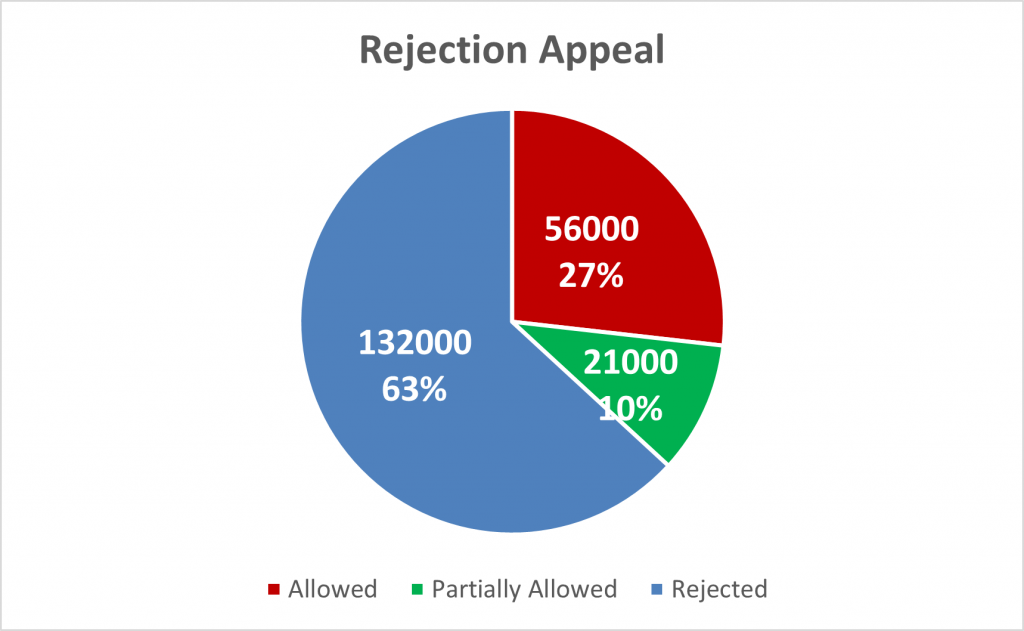
In 2021, among all 308,000 rejection appeal cases, 209,000 cases can be collected from a third party website to show that 63% of the rejection appeal are unsuccessful and that leaves 37% successful challenges.
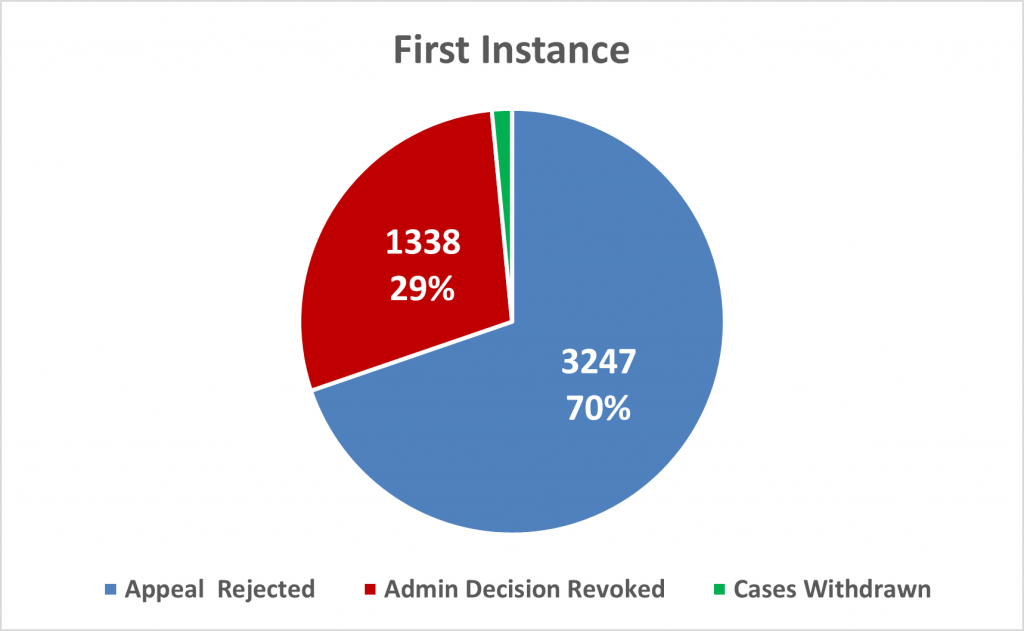
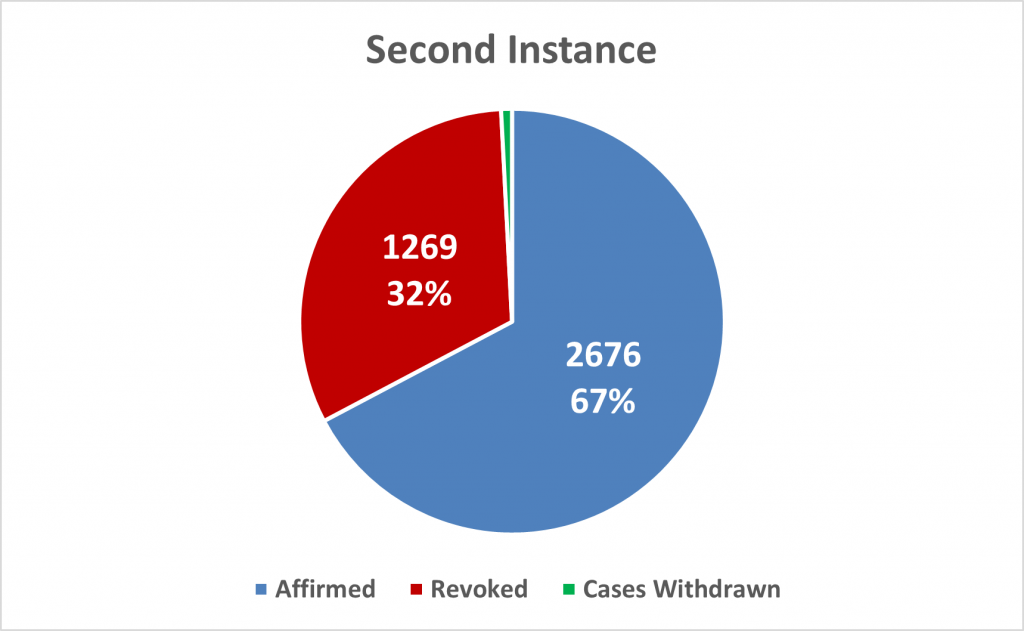
The success rate for first instance appeal against unfavorable rejection appeal decision is only 29%, however, the success rate at the second instance appeal increases slightly to 32%.
Trademark opposition statistics
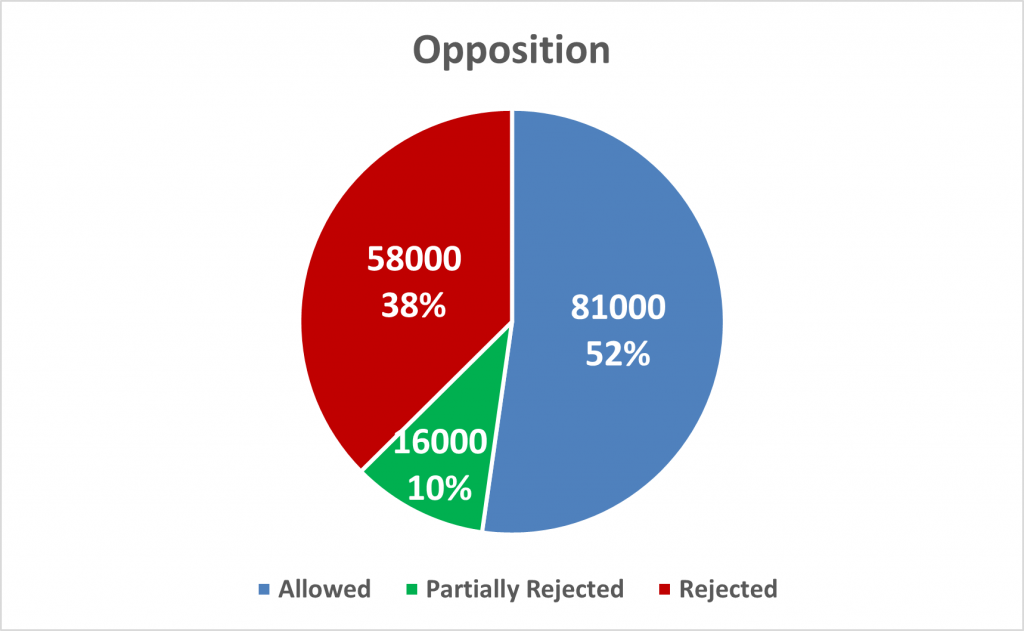
In 2021, among the 155,000 cases that can be collected from a third party website, opposition success rate, including partially rejected case, is 48%.
Invalidation and related administrative litigation statistics
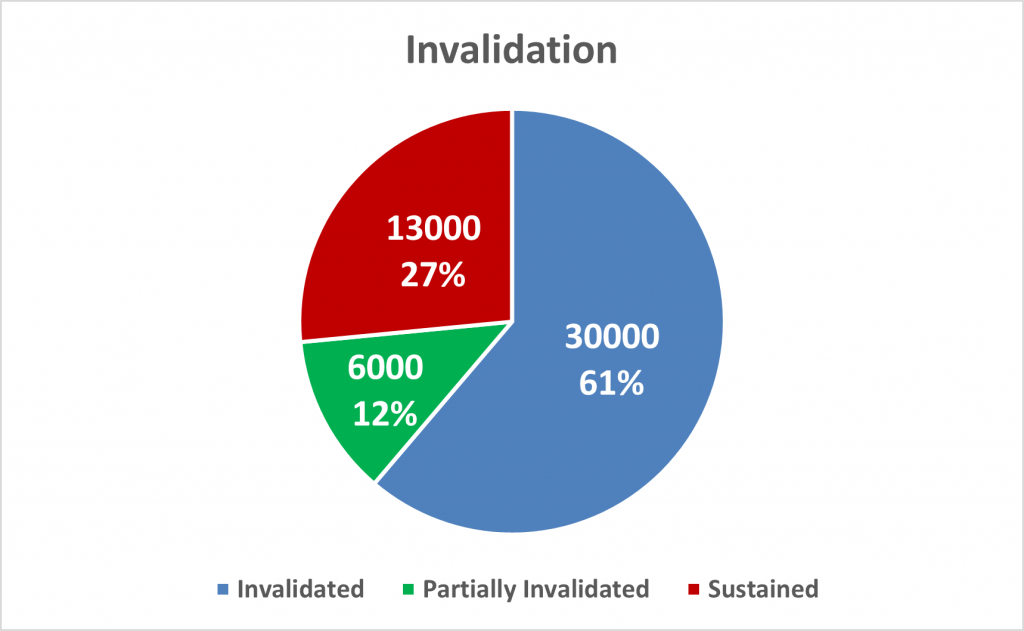
In 2021, the CNIPA decided 58,000 cases and 49,000 can be collected from a third party website, invalidation success rate is 73%.
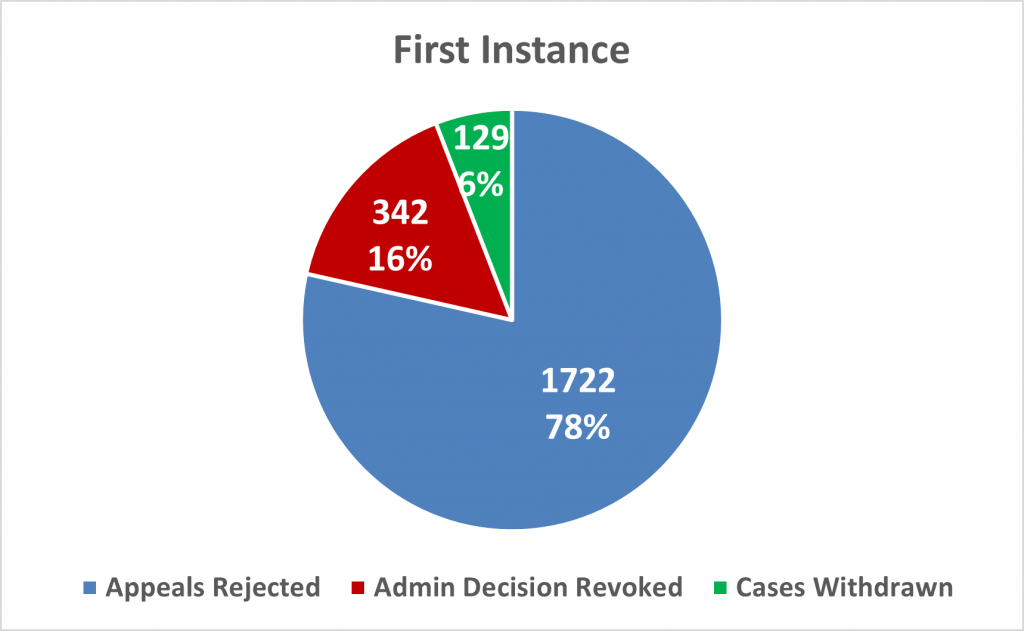
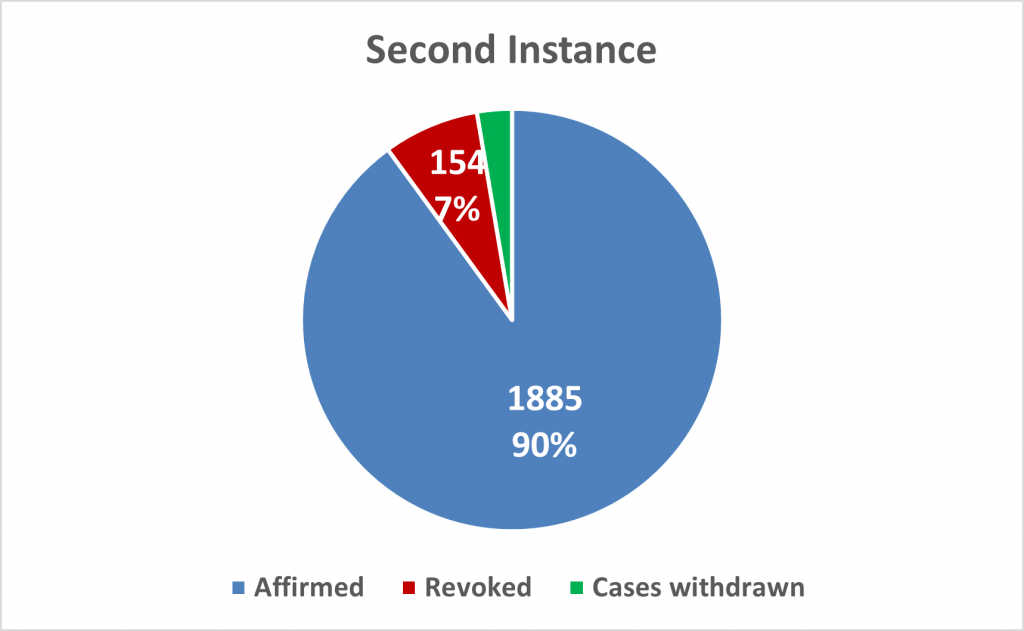
In 2021, the first instance invalidation success rate is 16% and the second instance success rate is only 8%.
Cancellation and related administrative litigation statistics
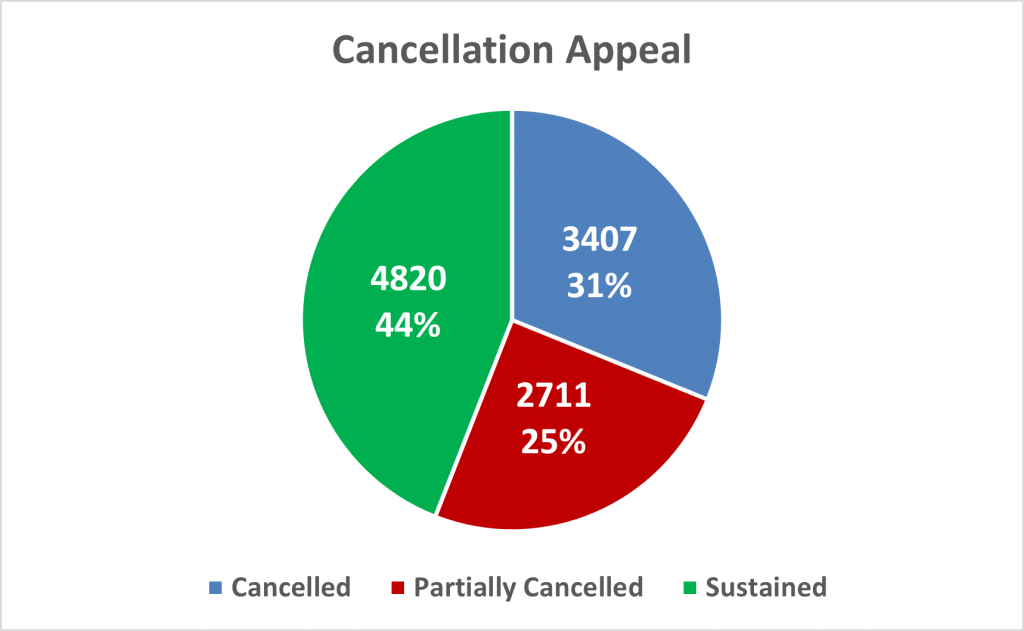
In 2021, among all 13,000 cancellation appeal cases, 11,000 can be collected from a third party website, cancellation appeal success rate, including partially cancelled, is 56%.
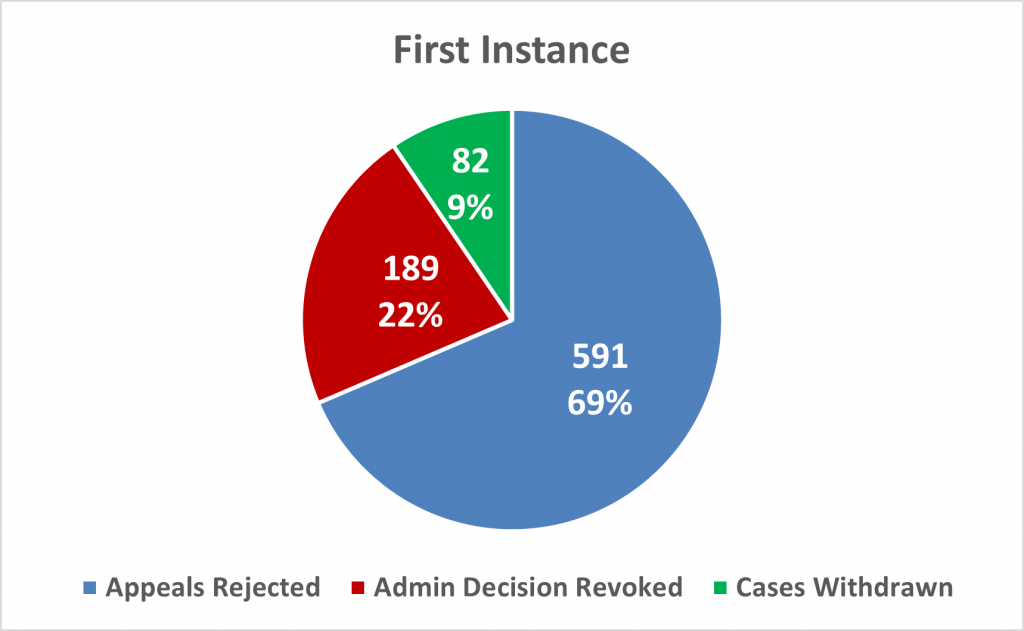
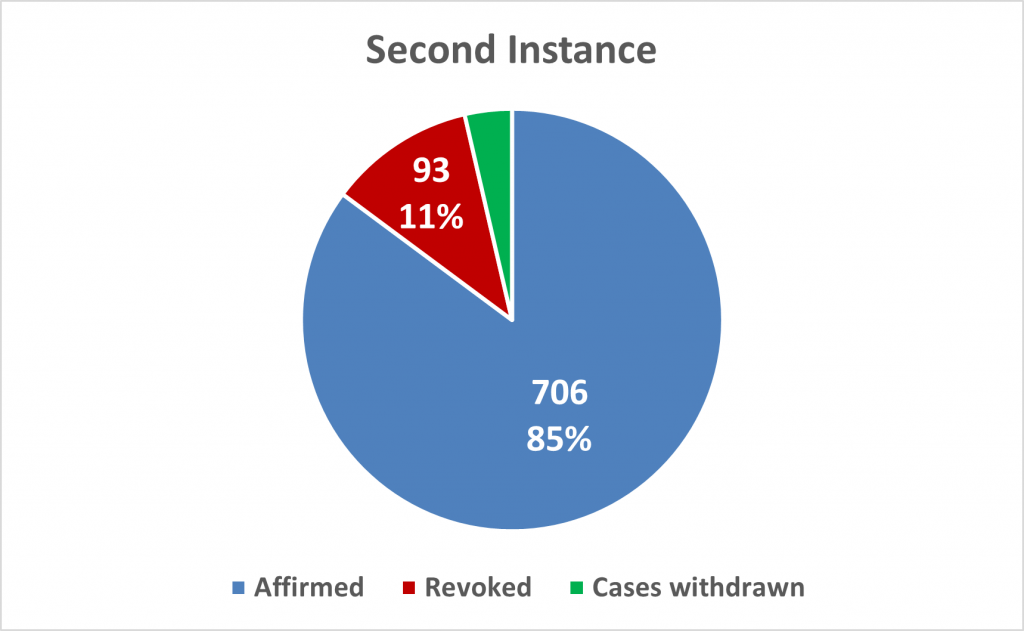
In 2021, the first instance cancellation appeal success rate is 22% and the second instance success rate is only 11%.
Please note that in 2021, the success rate to appeal the application not allowed for registration is only 15% before the CNIPA and that low success rate remains the same at first instance and drops to 5% at the second instance. Obviously, if a trademark application is not allowed for registration, it is recommended to discuss further with your Chinese trademark attorneys.


Follow us on LinkedIn!
Email: trademark@beijingeastip.com
Tel: +86 10 8518 9318 | Fax: +86 10 8518 9338
Address: Suite 1601, Tower E2, Oriental Plaza, 1 East Chang An Ave., Dongcheng Dist., Beijing, 100738, P.R. China -
Weekly China Trademark News Updates – December 29, 2021
2021-12-29
Weekly China Trademark News Updates
December 29, 2021
2021 turned out to be year one for all of us learning how to live with COVID-19. Across the world, various strategies have been implemented to adapt the new normal such as continuing wearing mask in crowded areas, keeping social distance, getting at least two doses of vaccine, and occasionally countries around the world would still implement partial or full lock down in order to contain the virus from spreading into the community. That said, social activities around the world have picked up where they left in 2019. 2020 Summer Olympics resumed in Japan, Tom Brady won another ring at Super Bowl LV, Tennis Grand Slams were held as scheduled around the world, Villarreal CF won the 2020 UEFA Euro. Many intellectual property related conferences were also resumed around the world. Beijing East IP attended INTA via its online platform and joined many table topics with our colleagues around the world. Although it was not the same as seeing them in person, definitely better than exchanging emails.
At Beijing East IP, we had to adapt new communication channels and our weekly China trademark news updates was one of the new channels. Our first update was published on January 15, 2021, and the one today will mark the end of the first full year of providing weekly China trademark news updates to our subscribers. We hope the contents have been interesting and informative to you and we will continue to provide this weekly updates into 2022. There may be new ideas from us to you in 2022, so stayed tuned and we will let our subscribers know as soon as the new materials are prepared. Stay tuned and wish everyone a Happy New Year of the Tiger!
1. Schneider Electric was awarded RMB 1 million in compensation in an unfair competition lawsuit
Schneider Electric (China) Co., Ltd. (“Schneider China”) sued Hangzhou Dongheng Electric Co., Ltd. (“Dongheng”) for using the domain name “www.schneider-china.com” and the corporate name of “Hangzhou Schneider Electric Co., Ltd.” in an unfair competition lawsuit.
The Second Instance Court found that Schneider China has invested in and established a number of companies with the name “Schneider in Chinese” since its establishment in 1995 in China and has won many awards. After continuous and extensive publicity, Schneider China’s “Schneider in Chinese,” “Schneider Electric in Chinese,” ” Schneider Electric,” and other trademarks obtained a high fame in the field of electrical products. At the same time, Schneider China has established a specific relationship with the products it provides. The “Schneider in Chinese” tradename has become an influential company brand that can be protected under the Chinese Anti-Unfair Competition Law. Dongheng used the words “Hangzhou Shinaide (Schneider in Chinese) Electric Co., Ltd.” on the “http://www.schneider-chinacom” website to offer for sale and sold electrical products such as circuit breakers. The “Shinaide” and the foreign language “schneider” used on Dongheng’s tradename and its domain name constituted as identical or similar marks to Schneider China’s “Schneider in Chinese” trade name. As a business operator of the same industry, Dongheng should be aware of the reputation of the “Schneider in Chinese” brand name. Dongheng continued to use “Shinaide” as its tradename and as part of its domain name of the accused website after it had previously undertook not to use “Shinaide” in its tradename in a lawsuit. Dongheng’s actions showed subjective intention to free ride other’s fame, and objectively caused confusion to the relevant public. Dongheng’s actions amounted to unfair competition. The court comprehensively considered the reputation of the “Schneider” brand name, the size of Dongheng, the duration of the infringement, the circumstances of the infringement, the bad faith of Dongheng, and the reasonable expenses Schneider China spent to stop the infringement and determined that Dongheng should compensate Schneider China for economic losses of RMB1 million (USD156,961) (including reasonable expenditure of RMB 120,000).
2. The Beijing High Court cited claim preclusion in affirming the “Rejoice in Chinese” trademark invalidation case
The “Rejoice in Chinese” trademark (“Disputed Mark”) with registration number 3313331 was filed by an individual He Dun on September 19, 2002. Proctor & Gamble (“P&G”) filed an opposition against the Disputed Mark when the Chinese Trademark Law 2001 was still in force. The Disputed Mark was later approved for registration after an opposition appeal, first instance, and second instance appeals.
While the Chinese Trademark Law 2013 was in force, P&G filed an invalidation against the Disputed Mark. After adjudication, the CNIPA invalidated the Disputed Mark because the Disputed Mark violated Article 13(2) of the Chinese Trademark Law 2013. He Dun was unsatisfied with the CNIPA’s decision and appealed to the Beijing Intellectual Property Court.
The Beijing IP Court found that the opposition filed by P&G in 2001 has clearly stated cited P&G’s own prior registered trademark “Rejoice in Chinese” with registration number 543381 and claimed that the Disputed Mark violated Article 13(2) of the Chinese Trademark Law 2001, which was an identical claim to this case. Evidence submitted for this case were identical to those submitted for the opposition filed based on the Chinese Trademark Law 2001, the evidence cannot reflect whether the time of its formation was after the opposition decision was made, there were no evidence showing that there were circumstances that could not be previously obtained due to objective reasons, or the evidence would have substantially affected the application of Article 13(2) of the Chinese Trademark Law 2001 in the opposition. Thus, P&G’s invalidation constituted as claiming identical facts and reasons to a prior case, which violated the principle of claim preclusion. P&G’s new citation of its registered trademark “Rejoice & Rejoice in Chinese & Design” with registration no. 3008024 did not violate the principle of claim preclusion, but the registration date was later than the application date of the Disputed Mark. Even if such mark was recognized with well-known mark status, P&G would not be able to prove that such mark had obtained well-known status prior to the Disputed Mark’s application date, because well-known mark protection for non-similar or non-identical goods can only extend to the registration date of the well-known mark. Accordingly, the Beijing IP Court concluded that the P&G’s invalidation was claim precluded because the same issue was previously decided on merit citing Article 13(2) of the Chinese Trademark Law, and revoked the CNIPA’s invalidation decision. The Beijing IP Court’s decision was then appealed to the Beijing High Court.
The Beijing High Court in its decision affirming the Beijing IP Court’s decision reasoned that “the scope of the administrative power of the people’s court for trademark granting and verification shall generally be determined based on the plaintiff’s litigation claims and reasons. If the plaintiff did not raise a claim in its complaint but the relevant findings of the Trademark Review and Adjudication Board were obviously improper, the people’s court may review the relevant matters and make judgments after the parties have stated their opinions.” The evidence in the case can prove that He Dun filed and obtained hundreds of trademarks identical or similar to other famous trademarks in Classes 3, 5, 16, 20, 24, 30, and 32, and failed to provide reasonable explanations on his intention and creative sources of the designs of his massive filings for distinctive and famous trademarks, which can be seen as He Dun has the subjective malice of plagiarizing and imitating other people’s trademarks, and constituted as bad faith registrations that should not be limited by the five-year limitation for filing invalidation under the Chinese Trademark Law. Considered that the CNIPA’s invalidation decision was revoked and the CNIPA was ordered to issue a new decision for the Disputed Mark, the Beijing High Court ordered the CNIPA to reexam the case based on Article 45(1) of the Chinese Trademark Law for He Dun’s bad faith.


Follow us on LinkedIn!
Email: trademark@beijingeastip.com
Tel: +86 10 8518 9318 | Fax: +86 10 8518 9338
Address: Suite 1601, Tower E2, Oriental Plaza, 1 East Chang An Ave., Dongcheng Dist., Beijing, 100738, P.R. China
-
ABOUT US
-
PRACTICES
-
NEWS & EVENTS
-
Other Links
-
Contact Us
- info@beijingeastip.com
- +86 10 8518 9318
- +86 10 8518 9338

